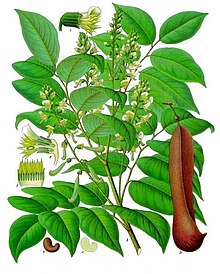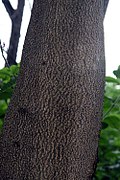
The Fabaceae or Leguminosae, commonly known as the legume, pea, or bean family, are a large and agriculturally important family of flowering plants. It includes trees, shrubs, and perennial or annual herbaceous plants, which are easily recognized by their fruit (legume) and their compound, stipulate leaves. The family is widely distributed, and is the third-largest land plant family in number of species, behind only the Orchidaceae and Asteraceae, with about 765 genera and nearly 20,000 known species.
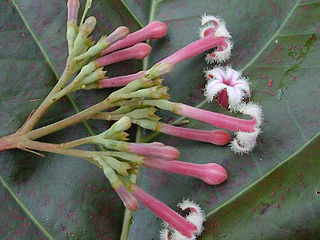
Cinchona is a genus of flowering plants in the family Rubiaceae containing at least 23 species of trees and shrubs. All are native to the tropical Andean forests of western South America. A few species are reportedly naturalized in Central America, Jamaica, French Polynesia, Sulawesi, Saint Helena in the South Atlantic, and São Tomé and Príncipe off the coast of tropical Africa, and others have been cultivated in India and Java, where they have formed hybrids.

Prosopis juliflora is a shrub or small tree in the family Fabaceae, a kind of mesquite. It is native to Mexico, South America and the Caribbean. It has become established as an invasive weed in Africa, Asia, Australia and elsewhere. It is a contributing factor to continuing transmission of malaria, especially during dry periods when sugar sources from native plants are largely unavailable to mosquitoes.

Mesua ferrea, the Ceylon ironwood, or cobra saffron, is a species in the family Calophyllaceae native to the Indomalayan realm. This slow-growing tree is named after the heaviness and hardness of its timber. It is widely cultivated as an ornamental for its graceful shape, grayish-green foliage with a beautiful pink to red flush of drooping young leaves, and large, fragrant white flowers. It is the national tree of Sri Lanka, as well as the state tree of Mizoram and state flower of Tripura in India.

Tolu balsam or balsam of Tolu is a balsam that originates from South America. It is similar to the balsam of Peru.

Senna tora is a plant species in the family Fabaceae and the subfamily Caesalpinioideae. Its name is derived from its Sinhala name tora (තෝර). It grows wild in most of the tropics and is considered a weed in many places. Its native range is in Central America. Its most common English name is sickle senna or sickle wild sensitive-plant. Other common names include sickle pod, tora, coffee pod and foetid cassia. It is often confused with Chinese senna or sickle pod, Senna obtusifolia.

Balsam of Peru or Peru balsam, also known and marketed by many other names, is a balsam derived from a tree known as Myroxylon balsamum var. pereirae; it is found in El Salvador, where it is an endemic species.
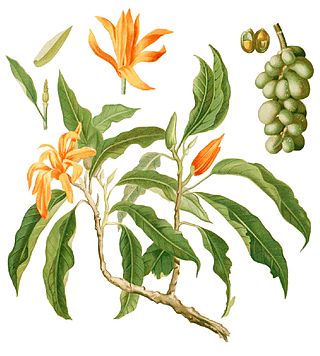
Magnolia champaca, known in English as champak, is a large evergreen tree in the family Magnoliaceae. It was previously classified as Michelia champaca. It is known for its fragrant flowers, and its timber used in woodworking.
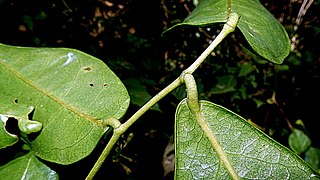
Poecilanthe is a genus of flowering plants in the family Fabaceae. It includes 9 species of trees and shrubs native to eastern, southern, and west-central Brazil, Bolivia, Paraguay, Uruguay, and northeastern Argentina. They grow in seasonally-dry tropical forest, woodland, thicket, and riverine forest.

Udawattakele Forest Reserve often spelled as Udawatta Kele, is a historic forest reserve on a hill-ridge in the city of Kandy. It is 104 hectares large. During the days of the Kandyan kingdom, Udawattakele was known as "Uda Wasala Watta" in Sinhalese meaning "the garden above the royal palace". The sanctuary is famous for its extensive avifauna. The reserve also contains a great variety of plant species, especially lianas, shrubs and small trees. There are several giant lianas. Many of small and medium size mammals that inhabit Sri Lanka can be seen here. Several kinds of snakes and other reptiles might be seen. Udawattakele was designated as a forest reserve in 1856, and it became a sanctuary in 1938.
Monopteryx is a genus of flowering plants in the family Fabaceae. It includes three species of trees native to the Amazon rainforest of northern South America, ranging through parts of Colombia, Venezuela, northern Brazil, and French Guiana. They grow in non-inundated lowland tropical rain forest on sandy soil. The genus belongs to subfamily Faboideae. Members of this genus produce hydroxypipecolic acids in their leaves.
Petaladenium urceoliferum is a species of flowering plant in the family Fabaceae. It is a tree native to northern Brazil. It grows in tropical lowland Amazon rain forest in the basin of the Rio Negro, a northern tributary of the Amazon. It is the only member of the genus Petaladenium. The genus belongs to tribe Amburaneae in subfamily Faboideae.
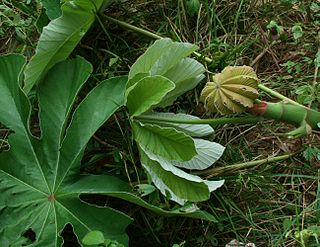
Cecropia peltata is a fast-growing tree in the genus Cecropia. Common names include trumpet tree, trumpet-bush, bacano, bois canon and snakewood. It is listed as one of the world's 100 worst invasive alien species.
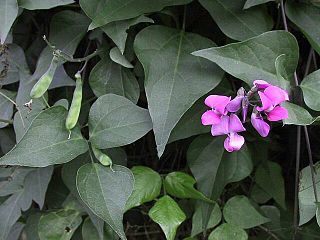
Dipogon lignosus, the okie bean, Cape sweet-pea, dolichos pea or mile-a-minute vine, is a species of flowering plant in the legume family, Fabaceae. It is the only species classified in the monotypic genus Dipogon which belongs to the subfamily Faboideae.
Tolú is a small town and municipality in Sucre Department, northern Colombia.
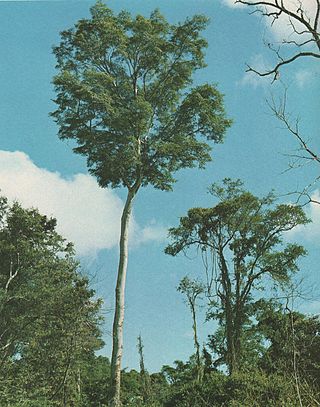
The tribe Amburaneae is one of the subdivisions of the plant family Fabaceae. It has been circumscribed to include the following genera, which used to be placed in tribes Sophoreae and Swartzieae:
Diospyros venosa is a tree in the family Ebenaceae. It is native to Southeast Asia, from the Maluku Islands to Myanmar. It provides raw material for handicrafts, traditional medicine and fuel.
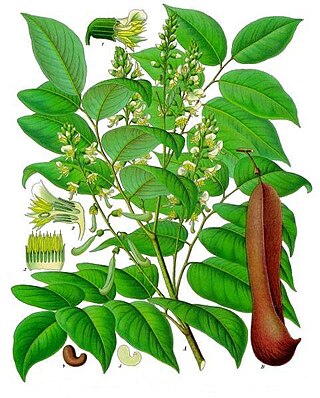
Myroxylon balsamum, Santos mahogany, is a species of tree in the family Fabaceae. It is native to tropical forests from Southern Mexico through the Amazon regions of Peru and Brazil at elevations of 200–690 metres (660–2,260 ft). Plants are found growing in well drained soil in evergreen humid forest.
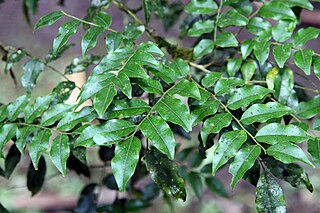
Myroxylon peruiferum, or quina, is a species of tree in the family Fabaceae. It is native to tropical forests of North and South America.

Vicia grandiflora, commonly known as large yellow vetch and bigflower vetch, as well as large-flowered vetch, is a common herbaceous plant species in the family Fabaceae, which occurs as a native plant species in Europe and Asia, as well as an introduced vetch species in North America.
